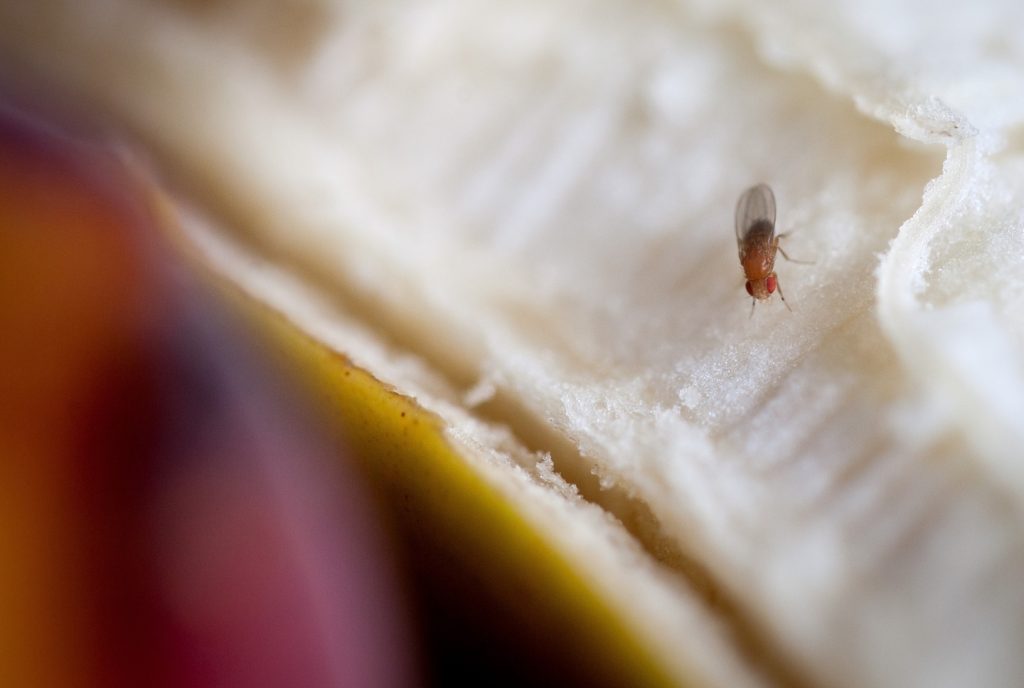Fruit flies, or Drosophila melanogasterDrosophila is one of the most widely studied organisms because it provides a cheap and accessible platform to study biological processes. Although fruit flies look quite different from humans, they share 75% of disease-causing genes, and scientists have used them to gain a better understanding of human diseases.
Researchers long ago documented that these tiny insects employ a deliberate strategy called cast-and-surge to find food sources in windy environments: In this technique, fruit flies smell something tasty, follow the scent by charging upwind, and then cast left or right to search for that scent again when they lose it.
Scientists explain that capturing a wind-blown scent doesn’t necessarily mean that the source is nearby — rather, a breeze is more likely to have carried the scent from far away — so the cast-and-surge method is an effective way to pinpoint the source of a wind-blown scent.
So what happens if there is no wind?
“They have another trick up their sleeve,” says Marcus Stensmer, an associate professor of sensory biology at Lund University, who was not involved in the study.
No-wind trick: Flies use downward circling movements. The authors found that when flies encounter an odor in still air and then lose sight of the odor, they will circulate downward in an attempt to find the source of the odor.
The behavior may not seem all that shocking — most cartoons depicting flies buzzing around piles of smelly food — but this is the first time scientists have documented how fruit flies behave in a still-air environment, confirming a long-held human intuition.
Smelling in still air indicates that the source is probably nearby, making the sink-and-circle approach more useful.
Some researchers propose that dogs and rats exhibit similar behaviors, such as sniffing high and low to distinguish scents.
To proceed, the authors first had to find a way to stimulate the flies’ sense of smell in a windless environment. But how do you communicate smell when there’s no wind? David Stupsky, lead author of the study and a postdoctoral researcher in biology and engineering at the University of Nevada, Reno, said the scientists An approach called “virtual reality for the sense of smell.”
The researchers used genetically modified flies that contained light-activated neurons in their antennae, the equivalent of a fly’s nose. As a result, they were able to stimulate the flies’ sense of smell using flashes of red light instead of actual odors. This light-based approach allowed the researchers to get around the challenge of delivering a controlled cloud of odors that are hard to find in space.
The authors were able to easily switch the light on and off to deliver light precisely as a substitute for smell. The researchers performed their study in a custom-built wind tunnel equipped with 12 cameras to track the fly’s movements in three dimensions. Monitoring insects in their natural flight is notoriously difficult, and therefore much research has been done on walking flies, as their movements span two dimensions rather than three.
The authors observed that fruit flies behave differently in response to air conditions and inferred that the flies can sense both the presence and direction of wind.
“If you stick your head out the car window while driving, can you tell if there’s a breeze?” asked Floris van Bruegel, the study’s lead researcher and assistant professor of mechanical engineering. It’s hard to sense a breeze while moving through the air, but fruit flies are just good at it.
The authors suggest that when flies encounter an odor, they slow down and change direction, thereby determining whether there is wind and where it is coming from.
“This is some pretty complicated computation going on in this very small, presumably simple brain,” said Elizabeth Hong, a professor of neuroscience at the California Institute of Technology who was not involved in the study.
Neurobiology expert Professor Richard Benton of the University of Lausanne says understanding how fruit flies detect smells could help scientists better understand harmful pests like mosquitoes, who are particularly interested in disrupting mosquitoes’ ability to find and feed on humans in order to reduce disease transmission.
A fly’s sense of smell could also be useful for the next generation of tracking devices designed to track down the source of indoor chemical leaks.
Perhaps this research will bring some respect to fruit flies: after all, they have figured out how to coexist with humans by following scents through our windless homes.
“Their brains are very small,” Benton said, “but they do a lot with them.”


